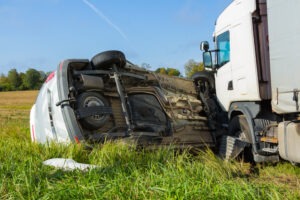
It is an unfortunate reality that truck accidents are a common occurrence on our roads. With the number of trucks transporting goods increasing yearly, it is essential to understand the trends and factors contributing to these accidents.
This blog post aims to comprehensively analyze truck accident statistics, breaking down the causes, consequences, and potential ways to minimize their frequency. We will delve into the data to uncover the truth behind these alarming numbers and explore solutions to make our roads safer for all.
The Scope of the Problem: Understanding the Numbers
Each year, thousands of truck accidents occur across the United States. In 2020, large trucks were involved in 4,444 fatal crashes, according to the Federal Motor Carrier Safety Administration (FMCSA). Large trucks account for nearly 13% of all traffic fatalities, despite representing only 4% of registered vehicles.
When examining the overall trends, we see that truck-related fatalities have risen over the past decade. From 2009 to 2019, there was a 31% increase in fatal crashes involving large trucks. This rise in accidents can be attributed to various factors, including increased freight demand and the pressure on truck drivers to meet tight delivery schedules. According to the National Highway Traffic Safety Administration, 74% of fatalities in large truck crashes were occupants of other vehicles.
Our Team Is Here To Assist You Every Step Of The Way.
SPEAK TO AN ATTORNEY TODAYBehind the Wheel: Common Causes of Truck Accidents
Truck accidents can occur for numerous reasons, some unique to large vehicles. Common causes include:
- Driver Fatigue: Long hours on the road can lead to driver exhaustion, impacting reaction times and decision-making abilities. The FMCSA has implemented regulations, such as the Hours of Service (HOS) rules, to reduce driver fatigue by limiting the number of hours a driver can operate a commercial vehicle.
- Distracted Driving: Texting, eating, or engaging in any other activity that diverts a driver’s attention from the road can result in accidents.
- Speeding: Excessive speed contributes to many truck accidents, as it can make it more challenging for a large vehicle to stop or maneuver safely.
- Poor Vehicle Maintenance: Regular maintenance is critical for ensuring the safe operation of large trucks. Issues such as faulty brakes or worn tires can lead to catastrophic accidents.
- Inadequate Training: Insufficient training or a lack of experience can make it difficult for truck drivers to handle difficult driving situations or safely navigate hazardous road conditions.
The Ripple Effect: Consequences of Truck Accidents
Truck accidents can have severe and far-reaching consequences that affect the individuals directly involved and society as a whole. Some of the significant impacts of these accidents include:
Fatalities
As mentioned, thousands of lives are lost yearly in large truck accidents. These devastating events leave families grieving and communities reeling from losing loved ones. The emotional toll on all those involved, including first responders and witnesses, cannot be overstated.
Injuries
Truck accidents often result in severe and life-altering injuries, such as traumatic brain injuries, spinal cord injuries, and fractures. The victims of these accidents may require extensive medical treatment, rehabilitation, and ongoing care. The physical and emotional pain associated with these injuries can lead to long-term disabilities, impacting the victim’s quality of life and ability to work or engage in daily activities.
Property Damage
Large trucks can cause significant property damage in the event of an accident. This includes damage to other vehicles, roadside structures, and personal property. In some cases, the cost of repairs or replacement can be astronomical, adding to the financial strain experienced by those affected.
Environmental Impacts
Spills from truck accidents, particularly those involving hazardous materials, can have severe and long-lasting environmental consequences. These spills can contaminate soil, groundwater, and surface water, endangering wildlife and ecosystems. Cleanup efforts can be costly and time-consuming, and in some cases, the damage may be irreversible.
Economic Costs
The financial burden of truck accidents extends beyond the immediate expenses related to medical care, property damage, and environmental cleanup. There are indirect economic costs, such as lost productivity due to injuries or fatalities, increased insurance premiums, and the strain on emergency services and healthcare systems. These economic impacts can affect the local, state, and even national economies, highlighting the importance of addressing truck safety.
Psychological Effects
The trauma experienced by those involved in or witnessing a truck accident can lead to long-lasting psychological effects, such as post-traumatic stress disorder (PTSD), anxiety, and depression. These mental health challenges can further impact the victim’s ability to return to work, maintain relationships, and engage in daily activities.
Legal Ramifications
Truck accidents can also lead to complex legal battles involving multiple parties, including trucking companies, insurance providers, and individuals. These legal proceedings can be lengthy and expensive, adding additional stress to those involved.
The consequences of truck accidents extend far beyond the incident’s immediate aftermath. The ripple effects are felt in various aspects of society, from the environment to the economy. It is essential to continue working towards reducing the frequency and severity of truck accidents to minimize these consequences and create safer roadways for all users.
Prevention Strategies: Making Our Roads Safer
Understanding the causes and consequences of truck accidents is vital in identifying effective prevention strategies. By examining the various factors that contribute to these incidents, we can implement targeted solutions to address each specific cause. Some possible solutions include those referenced below.
Strengthening Regulations
Ensuring strict adherence to regulations, such as Hours of Service (HOS) rules, can help reduce the risk of driver fatigue-related accidents. More rigorous inspections and enforcement can ensure that trucking companies and drivers comply with these rules, improving safety. Additionally, revisiting current regulations and adapting them to the evolving landscape of the trucking industry can help minimize potential risks.
Implementing Advanced Safety Technologies
Adopting cutting-edge technologies, such as collision avoidance systems, lane departure warnings, and electronic stability control, can significantly enhance truck safety by assisting drivers in avoiding potential accidents. These systems can alert drivers to potential hazards, enabling them to take corrective actions to prevent collisions. Furthermore, integrating telematics systems can help monitor driver behavior and identify areas where additional training or intervention may be necessary.
Enhancing Driver Training
Comprehensive and ongoing driver training programs can better prepare truck drivers for various driving conditions and situations. Such programs should cover defensive driving techniques, advanced maneuvering skills, and strategies for handling adverse weather conditions. Additionally, training should emphasize the importance of proper vehicle maintenance and the dangers of driving while fatigued, distracted, or under the influence of drugs or alcohol.
Continuing education and refresher courses can help drivers remain current on best practices and industry standards.
Improving Infrastructure
Investing in well-maintained roads and rest areas can reduce the likelihood of accidents caused by poor road conditions or driver fatigue. This includes addressing issues like potholes, inadequate lighting, and poorly designed intersections.
Adequate rest areas should be provided regularly along highways to allow drivers to take breaks and rest, reducing the risk of fatigue-related accidents. Furthermore, developing intelligent transportation systems that provide real-time information on traffic and road conditions can help drivers make better-informed decisions.
Raising Public Awareness
Public education campaigns highlighting the risks associated with large trucks and promoting safe driving practices can play a crucial role in reducing the incidence of truck accidents. These campaigns can target truck drivers and other road users, emphasizing the importance of sharing the road responsibly and respecting the limitations of large vehicles. Initiatives such as “No-Zone” campaigns, which educate drivers about the blind spots around large trucks, can help prevent accidents caused by cars entering areas where truck drivers have limited visibility.
Truck accidents are a significant road concern, contributing to thousands of yearly fatalities and injuries. By understanding the causes and consequences of these accidents, we can work towards implementing effective prevention strategies. From strengthening regulations to investing in advanced safety technologies, numerous ways exist to make our roads safer for all users. By taking a proactive approach to address this issue, we can hope to see a decline in truck accident statistics and create a safer environment for everyone who shares the road.
BDIW Law is an excellent resource for those looking to learn more.








